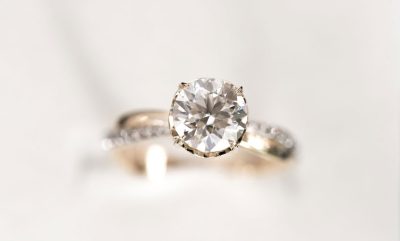The price of a 1 carat diamond can go from $1,200 to over $16,000 (United States dollars). But why is there such a huge price difference for a small piece of gemstone of the same size? Why are some diamonds so expensive? And why are some diamonds cheaper while other diamonds are much more expensive?
How beautiful each diamond looks might be subjective to us but to the businesses selling them, there is a way to measure its value. The price of a diamond is calculated based on its quality, size, rarity, and even the brand associated with the diamond.
Here’s a breakdown of the key factors that differentiate them:
1. Quality (The 4 Cs Of A Diamond)
- Cut: The cut of a diamond greatly affects its brilliance and fire. Expensive diamonds often have a superior cut, maximizing their sparkle, while cheaper diamonds may have a less precise cut, affecting their brilliance.
- Color: Diamonds are graded on a color scale from D (colorless) to Z (light yellow or brown). Colorless diamonds, which are rarer, fall on the higher end of the scale and are more expensive. Cheaper diamonds may have noticeable coloration.
- Clarity: This refers to the absence of inclusions and blemishes. Expensive diamonds typically have higher clarity, meaning fewer visible flaws. Cheaper diamonds often have more inclusions or blemishes visible to the naked eye or under magnification.
- Carat Weight: Larger diamonds are rarer and, therefore, more expensive. A higher carat weight significantly increases the price, while smaller, less weighty diamonds are cheaper
Read more about the 4Cs of diamond.
2. Rarity & Origin
Rare diamonds, such as those with unusual colors (like pink or blue), are significantly more expensive due to their scarcity. The origin of the diamond can also influence its cost; for instance, diamonds with a known, conflict-free origin may carry a premium.
3. Brand & Certification
Diamonds from prestigious brands (such as Tiffany & Co) or those that come with a certification from a reputable laboratory (like the GIA or AGS) typically command higher prices. These certifications assure the buyer of the diamond’s quality according to standardized grading systems.

4. Craftsmanship & Setting
The craftsmanship of the diamond, particularly how it’s cut and polished, plays a role in its price. A well-crafted diamond will exhibit more fire and brilliance. Additionally, the quality and design of the setting can also contribute to the overall cost of the diamond jewelry.
5. Market Demand
Market demand can influence diamond prices. Certain shapes, sizes, and types of diamonds may be in higher demand, which can drive up their price.
6. Treatment
Some cheaper diamonds may have been treated (e.g., through heat or fracture filling) to improve their appearance. While these treatments can make a diamond more affordable, they typically reduce the diamond’s value compared to a natural, untreated stone.
Here is how the quality (the 4Cs of a diamond) can affect the prices of a 1-carat diamond.
- Lower quality 1-carat diamonds (poor cuts, lower color and clarity) might start as low as $2,000 – $3,000.
- Mid-range quality 1-carat diamonds could range from about $4,000 to $8,000.
- High-quality 1-carat diamonds, with excellent cuts, high color and clarity grades, could range from $8,000 to even over $12,000 or more.

So while cheap diamonds can offer a budget-friendly option, they often come with compromises in quality, size, and rarity. Expensive diamonds, on the other hand, boast superior quality, craftsmanship, and often come with the assurance of certification and brand reputation.
However, sometimes all that matters is what you think of the diamond. After all, beauty is in the eye of the beholder.








